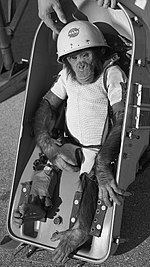 | ||
Died 19 January 1983, North Carolina Zoo, North Carolina, United States | ||
Ham (1956 – January 19, 1983), also known as Ham the Chimp and Ham the Astrochimp, was a chimpanzee and the first hominid launched into space, on 31 January 1961, as part of America's space program. Ham's name is an acronym for the lab which prepared him for his historic mission — the Holloman Aerospace Medical Center, located at Holloman Air Force Base in New Mexico.
Contents
Early life
Ham was born in 1956 or 1957 in Cameroon, captured by animal trappers and sent to Rare Bird Farm in Miami, Florida. He was purchased by the United States Air Force and brought to Holloman Air Force Base in 1959.
There were originally 40 chimpanzee flight candidates at Holloman. After evaluation, the number of candidates was reduced to 18, then to 6, including Ham. Officially, Ham was known as No. 65 before his flight, and only renamed "Ham" upon his successful return to Earth. This was reportedly because officials did not want the bad press that would come from the death of a "named" chimpanzee if the mission were a failure. Among his handlers, No. 65 had been known as Chop Chop Chang.
Training and mission
Beginning in July 1959, the three-year-old chimpanzee was trained under the direction of neuroscientist Joseph V. Brady at Holloman Air Force Base Aero Medical Field Laboratory to do simple, timed tasks in response to electric lights and sounds. In his pre-flight training, Ham was taught to push a lever within five seconds of seeing a flashing blue light; failure to do so resulted in an application of a mild electric shock to the soles of his feet, while a correct response earned him a banana pellet.
What differentiates Ham's mission from all the other primate flights to this point is that he was not merely a passenger, and the results from his test flight led directly to the mission Alan Shepard made on May 5, 1961 aboard Freedom 7.
On January 31, 1961, Ham was secured in a Project Mercury mission labeled MR-2 and launched from Cape Canaveral, Florida, on a suborbital flight. Ham had his vital signs and tasks monitored using computers on Earth. The capsule suffered a partial loss of pressure during the flight, but Ham's space suit prevented him from suffering any harm. Ham's lever-pushing performance in space was only a fraction of a second slower than on Earth, demonstrating that tasks could be performed in space. Ham's capsule splashed down in the Atlantic Ocean and was recovered by a rescue ship later that day. He only suffered a bruised nose. His flight was 16 minutes and 39 seconds long.
Later life
After the flight, Ham lived for 17 years in the National Zoo in Washington, D.C., before joining a small group of captive chimps at North Carolina Zoo.
After his death in 1983, Ham's body was turned over to the Armed Forces Institute of Pathology for necropsy. Following the necropsy, the plan was to have him stuffed and placed on display at the Smithsonian, following Soviet precedent with pioneering space dogs Belka and Strelka. However, this plan was abandoned after a negative public reaction. Ham's remains, minus the skeleton, were buried at the International Space Hall of Fame in Alamogordo, New Mexico. Colonel John Stapp gave the eulogy at the memorial service. The skeleton is held in the collection of the National Museum of Health and Medicine.
Ham's backup, Minnie, was the only female chimpanzee trained for the Mercury program. After her role in the Mercury program ended, Minnie became part of an Air Force chimpanzee breeding program, producing nine offspring and helping to raise the offspring of several other members of the chimpanzee colony. She was the last surviving astro-chimpanzee and died at age 41 on March 14, 1998.
